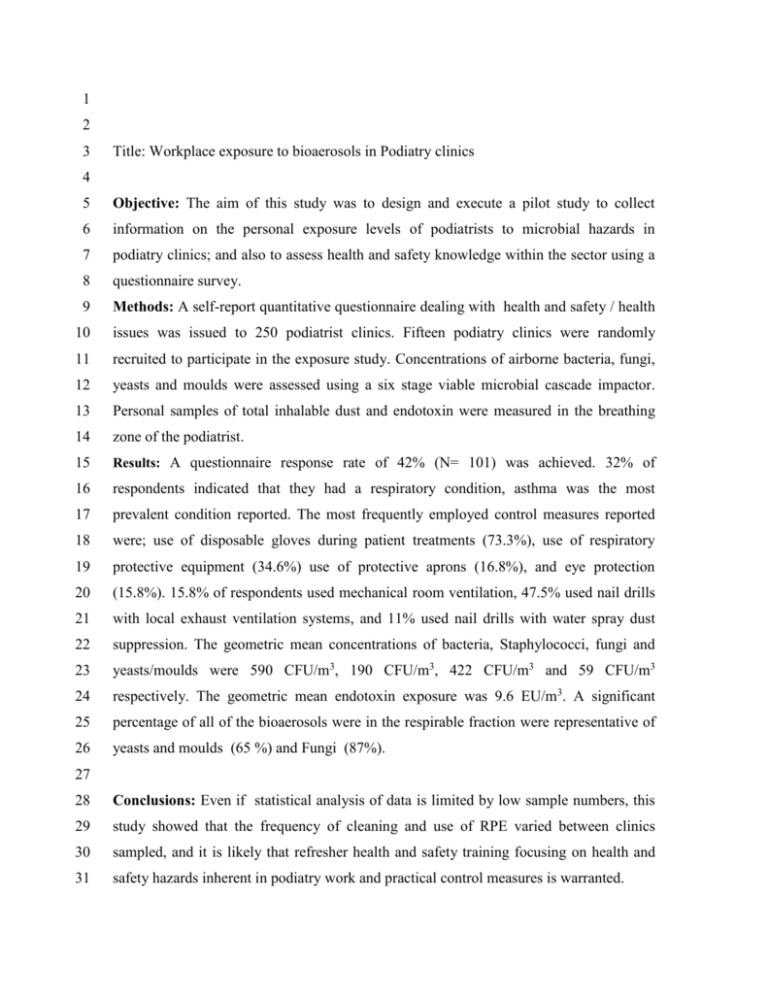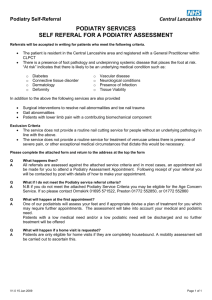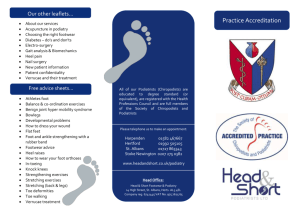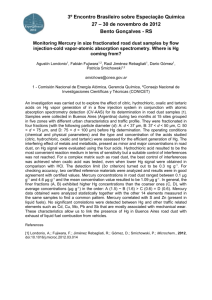1 - ARAN - Access to Research at NUI Galway
advertisement

1 2 3 Title: Workplace exposure to bioaerosols in Podiatry clinics 4 5 Objective: The aim of this study was to design and execute a pilot study to collect 6 information on the personal exposure levels of podiatrists to microbial hazards in 7 podiatry clinics; and also to assess health and safety knowledge within the sector using a 8 questionnaire survey. 9 Methods: A self-report quantitative questionnaire dealing with health and safety / health 10 issues was issued to 250 podiatrist clinics. Fifteen podiatry clinics were randomly 11 recruited to participate in the exposure study. Concentrations of airborne bacteria, fungi, 12 yeasts and moulds were assessed using a six stage viable microbial cascade impactor. 13 Personal samples of total inhalable dust and endotoxin were measured in the breathing 14 zone of the podiatrist. 15 Results: A questionnaire response rate of 42% (N= 101) was achieved. 32% of 16 respondents indicated that they had a respiratory condition, asthma was the most 17 prevalent condition reported. The most frequently employed control measures reported 18 were; use of disposable gloves during patient treatments (73.3%), use of respiratory 19 protective equipment (34.6%) use of protective aprons (16.8%), and eye protection 20 (15.8%). 15.8% of respondents used mechanical room ventilation, 47.5% used nail drills 21 with local exhaust ventilation systems, and 11% used nail drills with water spray dust 22 suppression. The geometric mean concentrations of bacteria, Staphylococci, fungi and 23 yeasts/moulds were 590 CFU/m3, 190 CFU/m3, 422 CFU/m3 and 59 CFU/m3 24 respectively. The geometric mean endotoxin exposure was 9.6 EU/m3. A significant 25 percentage of all of the bioaerosols were in the respirable fraction were representative of 26 yeasts and moulds (65 %) and Fungi (87%). 27 28 Conclusions: Even if statistical analysis of data is limited by low sample numbers, this 29 study showed that the frequency of cleaning and use of RPE varied between clinics 30 sampled, and it is likely that refresher health and safety training focusing on health and 31 safety hazards inherent in podiatry work and practical control measures is warranted. 1 2 Introduction 3 4 Many studies have shown that occupational exposure to bioaerosols and organic 5 dusts can cause adverse health effects such as infectious and respiratory diseases, and 6 cancer (Lacey and Crook, 1988, Sigsgaard et al, 1994, Blair et al, 1992, Donham et al, 7 1986, Douwes et al, 2003, Thorne and Duchaine 2007). The medical and health sectors 8 have been identified as having an increased risk of contracting occupational infectious 9 diseases due to the potential for bioaerosol exposure within their work environment 10 (Douwes et al, 2003, Matheson et al, 2005). However, within the health sector 11 occupational exposures in podiatry practice have received little attention (Burrows and 12 McLarnon, 2006, Rees, 2008). 13 Podiatry is a healthcare profession that specialises in the management of disease and 14 disorders of the lower limb and foot. Podiatric treatments such as the reduction of thickened toe 15 nails, onychomycotic nails, foot calluses or corns have the potential to generate substantial 16 concentrations of organic dusts which could pose an occupational hazard to those exposed. It is 17 estimated that up to 3 grams of toe nail dust may be generated per day in a podiatry practice 18 (Davies and Ganderton, 1975). Studies of the morphology and particle size of toe nail dust 19 generated from podiatric nail drills, show that toe nail dust particles are plate like in shape 20 allowing them to remain airborne for long periods. Particles are largely respirable, with 21 greater than 80% of the particles within a 0.8 – 1.6 µm particle size range, thus once 22 inhaled these particles are capable of penetrating the lower lung (Abrahamson and 23 Wilton, 1985a, Donaldson, 2003). Toe nail dust has been shown to be a Type I Allergen 24 (Davies, 1984) rich in endotoxin and fungi species. Endotoxin is an amphiphilic 25 component of the outer cell wall of Gram negative bacteria, has strong innate immune 26 and pro-inflammatory properties and has been shown to be an important factor in the 27 etiology of lung diseases such as COPD and non allergic asthma (Hadina et al. 2008; 28 Douwes et al, 2003). Toe nail dust generated from the treatment of onychomycotic nails is 29 rich in fungi species such as Trichophyton mentagrophytes, and Trichophyton rubrum, 30 (Albert and Weis, 2004; Donaldson et al, 2003; English, 1972). 31 Previous research carried out by McLarnon (2000) among podiatrists in the 32 United Kingdom found the prevalence of asthma among podiatrists to be 13% which is 1 higher than the UK’s national average, and a high prevalence of eye irritation and respiratory 2 complaints has been reported in this occupational group. Podiatrists have also been shown to have 3 a higher prevalence of precipitating antibodies for T. rubrum compared to the general 4 public (Abramson and Wilton, 1985b, Davies, 1984). However the health implications of 5 inhaling toe nail dusts are inconclusive (Gately, 1991). 6 To the authors’ knowledge there have been few studies which have characterized 7 the personal exposures of podiatrists, and few that have evaluated the use of exposure 8 controls and assessed the level of knowledge of occupational exposure hazards among 9 podiatrists. This information is required to adequately estimate the health risks of this 10 work, to aid the selection of appropriate exposure controls, and to develop appropriately 11 tailored hazard communication programmes for inclusion in educational podiatry 12 programmes. 13 The aim of the present study was to design and execute a pilot study to evaluate the 14 personal exposure of podiatrists to microbial hazards in podiatry clinics, namely airborne 15 bacteria, fungi, yeasts and endotoxin. A further aim of this study is to conduct a national 16 of survey of podiatrists working in private practice in Ireland, to assess health and safety 17 knowledge and to evaluate the use of exposure controls within the sector. It is anticipated 18 that the results from this study will perform the basis for a larger study on occupational 19 exposures in podiatry. 20 21 22 23 24 25 Methodology 26 27 Questionnaire survey 28 29 A self-report quantitative questionnaire was employed in this study, and no medical 30 assessments were undertaken. 31 questions and one qualitative open-ended question designed to elicit information on the The questionnaire consisted of twenty four closed 1 practice of occupational health and safety in podiatry. The sub – scales contained within 2 the questionnaire were deemed appropriate for the objectives of this study. 3 4 As there is no single professional body/regulatory agency for podiatrists in Ireland, the 5 only direct method of identifying potential participants was through the National 6 telephone directory and School of Podiatry at NUI, Galway. A list of 250 podiatrists 7 practicing in Ireland was compiled utilizing an online telephone listing website. 8 Additional podiatrists were identified by a staff member in the School of Podiatry in NUI 9 Galway. Only podiatrists in private practice were included in this study. As this research 10 is exploratory, it was decided to conduct a full population survey. The questionnaire was 11 posted with an explanatory cover letter to all identified podiatrists and reminder phone 12 calls were used to follow-up with all non-responders. 13 14 15 16 17 Sampling methodology 18 19 Fifteen podiatry clinics with between 1 and 3 podiatricians were randomly recruited to 20 participate in the exposure study. Exposure sampling was conducted over the Summer 21 Autumn period June – November 2010. All exposure sampling was completed by a 22 trained Occupational Hygiene research student, who stayed at the podiatry clinic for the 23 duration of the monitoring period. Prior to the survey each podiatrist was asked to 24 complete a short questionnaire which asked questions regarding their podiatry treatment 25 room, for example presence of exposure controls, room ventilation, cleaning regime etc. 26 Podiatrists were asked to complete a work diary at 30 minute intervals and asked to 27 indicate whether pre defined activities, likely to generate toe nail dust were performed. 28 They were also asked to indicate the number of patients treated over the sampling period. 29 Air-borne microorganisms were sampled by means of a six stage viable microbial 30 cascade impactor (TE-10-800, Tisch Environmental, Inc. USA) which was placed on the 31 podiatrists clinical unit, in between the podiatrist and the patient. The aerodynamic 1 diameter range for each stage was as follows: Stage 1 > 7µm, Stage 2, 4.7-7.0µm, Stage 2 3, 3.3-4.7µm, Stage 4, 2.1-3.3µm, Stage 5, 1.1-2.1µm and Stage 6, 0.65-1.1µm. Air (28.3 3 l/min) was impacted for three minutes onto the agar plates. These contained supplier- 4 validated non-selective (for total viable aerobic microorganisms) or selective media the 5 latter of which subsequent to incubation supported the growth of staphylococci and fungi 6 (including moulds and yeasts). Each of the fifteen participating clinics were sampled for 7 one day and samples were taken in the morning before the first patient was admitted to 8 the clinic and again after the last patient had left. Duplicate samples were taken for each 9 of the 6 size fractions, and less than eight minutes elapsed between taking the second 10 sample. The mean of the two samples was used for further analysis, 90 samples were 11 collected in total, and 30 samples analysed for total bacteria, 30 samples analysed for 12 staphylococci and 30 analysed for fungi (including moulds and yeasts). It was only 13 possible to use the results from 72 samples, the remaining 18 samples were discarded as 14 the sample plates were either aseptically compromised during transport to the laboratory, 15 were statistically uncountable due to the proliferation of “spreading microorganism”, or 16 because of excessive medium drying during incubation. 17 18 Personal samples of total inhalable dust and endotoxin were collected in the breathing 19 zone of the podiatrist (sample cassettes were clipped onto the podiatrist’s lapel). 20 Sampling commenced in the morning before the podiatrist started work and continued for 21 the full work day, samples were collected at the end of the working day. Samples were 22 collected on to 25mm glass fibre filters (Pall Gelman Sciences) loaded into IOM 23 inhalable dust sampler cassettes (Institute of Occupational Medicine, Edinburgh, UK). 24 Filters were pre treated by heating at 2000C for 4hrs, cassettes and holders were washed 25 with E-Toxa clean (soaked in 1% E-Toxa clean overnight, rinsed 10 times with tap water, 26 5 times with DI water, one time with nanopure water and dried on room temperature). 27 Personal air sampling pumps (SKC Inc.,), with the volumetric flow rate constant at 2 28 litres per minute, were used to draw air through the filters. Flow rates were checked 29 before and after sampling using a Primary Air Flow Calibrator. Three podiatrists refused 30 to participate in the personal sampling, In total 12 personal measurements were collected 31 sampling times ranged from 210 to 420 minutes. 1 2 Sample analysis 3 All samples were transported back to the laboratory in a chilled box at 4C, where 4 possible within 1 hour after sampling. Samples of Total Bacteria (Total Viable Aerobic 5 count: TVC) were collected and enumerated using nutrient agar (NA: Oxoid, UK) 6 incubated at 30C for 3 days. Samples of Fungi (including moulds and yeasts were 7 collected and enumerated using lactic acid-adjusted Malt Extract Agar (MEA: 0xoid, 8 UK) incubated at 22C for 5 days. Samples of Staphylococci were collected and 9 enumerated using egg-yolk tellurite emulsion supplemented Bair-Parker medium (Oxoid: 10 UK) which were incubated at 37oC for two days. Samples of dermatophyte fungi were 11 collected using the settle plate technique on Dermasol Agar (Oxoid UK) and incubated at 12 22C for 2 to 4 weeks. Dermasol agar plates were monitored over the 4 week period and 13 microscopy was used to identify the presence of T. rubrum or other dermatophytes grown 14 on the agar, results were expressed as presence or absence of dermaphytes. Using positive 15 hole correction tables (Macher, 1989) the concentrations of total bacteria, fungi, yeasts 16 and moulds were calculated and expressed as colony forming units per m3 of air 17 (CFU/m3). 18 Personal inhalable air samples were analyzed for endotoxin as previously described 19 (Thorne 2000, Thorne et al. 2010). Briefly, sampling filters were extracted into 10 mL of 20 pyrogen-free LAL grade water (Lonza, Inc.) plus 0.05% Tween-20 (Fisher Scienctific), 21 shaken for 60 min and centrifuged for 15 min at 600 x g and decanted. Extracts were 22 assayed for endotoxin activity using a modification of the kinectic chromogenic Limulus 23 amebocyte lysate (LAL) assay with a 12-point standard curve (r2>0.995) ranging from 24 0.0249 to 50 EU/mL. Extracts were assayed at 4 dilutions in LAL water using a 37°C 25 microplate reader (SpectroMax 340, Molecular Devices) at 405 nm with readings taken 26 every 30 sec for 90 min. Four microplate wells served as assay blanks. 27 28 Statistical analysis 29 All statistical analysis was performed using SPSS (Version 18) and Minitab. The 30 normality of distribution of the bioaerosol concentrations data was checked using the 31 Shapiro–Wilk test. The distributions were lognormal distributed and so the data is 1 presented as geometric means, and geometric standard deviation (Table 3). Independent 2 student t-tests were used to compare concentrations of bioaerosols collected before the 3 first patient treatment with samples collected after the last patient treatment. Agreement 4 between bioaerosol concentrations and each of the following; the number of patients 5 treated, the number of onychomycotic nails treated (Fungi only), the total time using a toe 6 nail drill/grinder/nail file and endotoxin concentrations (Bacteria only) was assessed by testing 7 the significance of the Pearson correlation coefficient. 8 9 10 11 12 13 14 Results Questionnaire survey results A response rate of 42% (N= 101) was achieved to the questionnaire survey. The majority 15 of the survey respondents were female 87% (n=88) and 13% (n=13) were male. Most 16 respondents had been working in podiatry for a number of years, with 42% having 17 worked between 20-40 years, another 44% having worked in excess of ten years and the 18 minority (15%) had worked for less than 10 years. 19 20 As respiratory illness is the health outcome of most interest in this study, participants in 21 the questionnaire study were asked to indicate whether or not they had a work related 22 respiratory illness as diagnosed by their doctor. The questionnaire allowed respondents to 23 select more than one illness, and 32 out of the 101 survey participants indicated that they 24 had a respiratory condition (Table 1). Asthma was the most prevalent condition, with 25 eight podiatrists reporting this condition, followed by sinusitis (n=8), repeated chest 26 infections (n=6), persistent cough (n=5), nasal irritation (n=4) and bronchitis (n=2). The 27 data was analysed to assess the numbers of podiatrists suffering from individual 28 conditions only. 29 30 The questionnaire survey also investigated the use of exposure controls and protective 31 equipment in podiatry practice. Participants identified the frequency with which they 32 employed various control measures. From the self reported data it was found that the 33 most frequently employed control measures were; always wearing of disposable gloves 1 during patient treatments (73.3%); use of respiratory protective equipment (RPE) (34.6%) 2 was at a lower level; while consistent use of protective aprons (16.8%) and eye protection 3 (15.8%) were employed to a lesser degree (Table 2). The questionnaire did not require 4 respondents to provide detail regarding the protection factor of the RPE used. 5 6 The use of room mechanical ventilation systems, local exhaust ventilation, and dust 7 suppression systems, was also investigated in the questionnaire survey. Use of room 8 mechanical ventilation systems was very low (15.8% of respondents used mechanical 9 ventilation). Almost half (47.5%) of the respondents used nail drills with local exhaust 10 ventilation systems. However, the use of nail drills with water spray dust suppression was 11 far less common, with only 11% of respondents always using this equipment. 12 13 Exposure assessment results 14 15 The concentrations of airborne bacteria, fungi (including moulds) yeasts, Staphylococci, 16 and personal endotoxin exposures measured in podiatry clinics are presented in Table 3. 17 The geometric mean concentrations of bacteria, Staphylococci, fungi (including moulds) 18 and yeasts were 590 CFU/m3, 190 CFU/m3, 422 CFU/m3 and 59 CFU/m3 respectively. 19 The geometric mean endotoxin exposure was 9.6 EU/m3. The concentrations of bacteria 20 were much higher than the concentrations of fungi. Bioaerosol concentration data is 21 presented as CFU/m3 in Table 4 and the size distribution is plotted in Figures 1 and 2 as 22 bacteria CFU/m3/dLog Dp staphylococci CFU/m3/dLog Dp, fungi CFU/m3/dLog Dp, 23 yeasts and moulds CFU/m3/dLog Dp. dLog Dp is the Logarithmic width of the impactor 24 stage, presenting the concentration data as CFU/m3/dLog Dp, allows direct comparison 25 between the concentrations of different stages. 26 The highest concentration of bacteria and fungi (including moulds) occurred in stage 5 27 (1.1-2.1µm), followed by stage 4 (2.1-3.3µm). Highest concentrations of yeasts occurred 28 in stage 2 (4.7-7.0µm) followed by stage 4 (2.1-3.3µm). A significant percentage of all of 29 the bioaerosols were in the respirable fraction, ranging from 65 % (yeasts and moulds) to 30 87% (Fungi). There was no significant difference between the concentrations of 1 bioaerosols collected in the morning, prior to the first or second patient treatment 2 compared with samples collected in the evening, after the last patient treatment. 3 Correlations between bioaerosol concentrations (bacteria or fungi) and the number of 4 patients treated, total time using a toe nail drill/grinder/nail file, were all not significant 5 (p>0.05). Similarly there was no correlation found between fungal concentrations and 6 number of onychomycotic nails treatments within the clinics (p<0.05). 7 8 Endotoxin concentrations (expressed as 8 hour TWA) ranged from 0.5 to 32.6 EU/m3. 9 The highest endotoxin exposures were recorded in Clinic 7. Correlations between 10 endotoxin concentrations and total bacterial concentrations, total number of patients 11 treated, the total time using a toe nail drill, or the total time using a nail file or pumice 12 stone were not significant (p<0.05). 13 14 Discussion 15 16 Concentrations of total viable bacteria, fungi, yeasts/moulds and personal endotoxin 17 exposures were measured in podiatry clinics. To the authors knowledge there have been 18 no other studies reported concerning bioaerosol concentrations and endotoxin exposures 19 in podiatry. 20 The geometric mean concentrations of bioaerosols reported in this study are higher than 21 values reported for other clinical settings such as dentistry and hospital environments 22 (Monarca et al, 2000; Bennett et al, 2000; Kim and Kim, 2007), and lower than those 23 reported for residential dwellings (Nasir and Colbeck, 2010; DeKoster and Thorne, 24 1995). In the present study concentrations of bacteria were highest, followed by fungi 25 (including moulds) and yeasts. There were no visible signs of fungal or mould growth in any 26 of the clinics sampled. The maximum concentrations of all bioaerosols (apart from yeasts 27 and moulds) were isolated from Stage 5 (1.1 – 2.1 µm) (Figures 1 and 2). The size 28 distributions of bacteria and fungi (72 – 79%, 87% respirable) are comparable to those 29 reported for residential homes in the UK Nasir and Colbeck 2010, and the USA DeKoster 30 and Thorne, 1995, but slightly higher than those reported by Kim and Kim, 2007 for 31 hospitals environments. In this study the high fraction of respirable bioaerosols could 1 largely be due to microbial laden dust originating from the use of grinding tools used for 2 podiatric treatments within the clinics. Studies of toe nail dust particle size and 3 morphology on dust collected from toe nail drills have shown that toe nail dust is highly 4 respirable (Abrahamson and Wilton, 1985; Donaldson et al, 2002). Nine of the clinics 5 sampled in this study used a toe nail drill during the survey. Some clinics reported 6 spending up to 1.5 hours per day reducing the thickness and distortion of onychomycotic 7 nails using a toe nail drill or nail file. Highest concentrations of yeasts were found in 8 Stage 2 (4.7 – 7 µm). 9 All personal endotoxin exposures are less than the Dutch exposure standard limit of 90 10 EU/m3 for airborne endotoxin 11 0.5 – 32.68 EU/m3), but within the range of exposure concentrations reported for similar 12 clinical settings such as dentistry (Singh et al, 2010), or for indoor environments such as 13 office buildings and rural households (Thorne and Duchaine, 2007). 14 One of the most commonly performed treatments at the podiatry clinics during the survey 15 involved the drilling or filing of onychomycotic nails. As onychomycotic nails are caused by 16 dermatophytic fungi, the number of onychomycotic nail treatments performed should be one of 17 the main sources of airborne fungi within the clinic. There was, however, no dermatophytes 18 identified and there was no significant correlation (p>0.05) between the number of 19 onychomycotic nail treatments, or total time using a nail drill and total fungi concentrations. In 20 addition there was no significant correlation (p>0.05) between bioaerosol or endotoxin 21 concentrations and number of patients treated, even though previous studies have identified 22 building occupancy as a factor influencing bioaerosol concentrations in domestic settings (Nasir 23 and Colbeck, 2010). 24 Podiatrists indicated that they use a variety of disinfectants for cleaning, however the 25 frequency of cleaning varied between clinics. Two of the clinics reported cleaning the 26 immediate work area; patient chair, clinical unit, and podiatrists’ chairs once per day, the 27 remaining 10 clinics reported cleaning the immediate work area between each patient 28 treated. 75% of clinics sampled reported cleaning the treatment room once per week, and 29 a small number reported using a household floor brush or vacuum cleaner. An endotoxin 30 exposure concentration of 32.6 EU/m3 (8 hr TWA) was recorded in one clinic, where the 31 podiatrist reported using a household vacuum cleaner to clean the work area between 32 patient appointments. This was the highest endotoxin exposure value recorded in the DECOS (2010)). Concentrations are highly variable (range 1 study. The use of a household brush or vacuum cleaner for cleaning is likely to generate 2 high concentrations of bioaerosols, by re-suspension of settled microbial laden dust from 3 work surfaces. 4 Microbial laden respirable dust has the potential to deposit deep in the alveolar region of 5 the lung, and could have significant health implications for workers with respiratory 6 diseases such as asthma. During the field study it was observed that many of the 7 podiatrists sampled in this study wore gloves while treating a patient, however rarely 8 used respiratory protective equipment. When respiratory protective equipment was used, 9 surgical dust masks, without assigned protection factors, were typically worn. Similar 10 results were reported in the questionnaire survey, only 35% of podiatrists reported using a 11 dust mask and as many as 70% reported not having a mechanical ventilation system. 12 8% of the podiatrists who participated in the questionnaire survey, confirmed that they 13 had been diagnosed with asthma, this rate is 1% lower that the Irish National average 14 (Asthma Society of Ireland). Only 9% of questionnaire respondents suffered from nasal 15 irritation, significantly lower than the value of 57%, which was reported by Gately in 16 1991. A possible explanation for the large discrepancy in the two figures is that the 17 majority of the podiatrists who participated in Gately’s study were using toe nail drills 18 without extraction. Nowadays most of the toe nail drills available include an extraction 19 unit, and in this study 47% of the questionnaire respondents reported using nail drills with 20 dust extraction. 21 Given that this was a small study with 12 - 15 podiatry clinics participating, a larger scale 22 study is necessary, building on the findings of this pilot project, to better understand 23 occupational exposures within this under studied sector. Some conclusions can be made 24 from this initial study. The inconsistent cleaning and use of exposure control measures 25 observed in this study may be explained by a number of contributory factors; such as lack 26 of awareness of health risks posed by inhalable dusts. Given that most of the participants 27 in this study had been practicing for a number of years, and that there is no Regulatory 28 Podiatry body in Ireland, health and safety knowledge on topics such as infection control 29 and personal protective equipment may have been forgotten in the absence of any re- 30 fresher training. A starting point to address this gap could be the implementation of a 31 targeted health and safety guidance tool for practitioners to raise awareness of health and 1 safety hazards inherent in podiatry work incorporating practical control measures to 2 minimise risk. 3 4 5 6 7 8 9 Acknowledgements The authors would like to thank all of the podiatrists who took part in this study. Special thank you to; Orla O’Malley for her help with the questionnaire survey and to Dr Darius Ceburnis for his advice on sample analysis. 10 11 12 References: 13 toenails. Part I: Characterisation of particles. Journal of American Podiatric Medical 14 Association, 75: 563-567. Abramson, C. and Wilton, J. (1985a), Inhalation of nail dust from onychomycotic 15 16 Abramson, C. and Wilton, J. (1985b), Inhalation of Nail Dust from Onychomycotic 17 Toenails. Part II: Clinical and serological aspects. Journal of American podiatric medical 18 association, 82: 111-115. 19 20 Blair, A, Hoar Zahm, S., Pearce NE., Heineman, HF., Fraumeni, J.F., (1992) Clues 21 to cancer etiology from studies of farmers. Scandinavian Journal of Work 22 Environment and Health; 18: 209-15 23 24 Bennett, A.M., Fulford, M.R., Walker, J.T., Bradshaw, D.J., Martin, M.V., and 25 Marsh, P.D., (2000) Microbial aerosols in general dental practice. British Dental 26 Journal 189: 664-667 27 28 Burrows, J.G. & McLarnon, N.A. (2006), World at work: Evidence based risk 29 management of nail dust in chiropodists and podiatrists. Occupational and Environmental 30 Medicine, 63: 713-716. 31 32 Davies, R.R. (1984), Human Nail Dust in Chiropdial Practice: irritant, allergen, and 33 source of antibodies to Trichophyton rubrum, The Journal of The Royal Society of 34 Health, 104: 2-5. 1 2 Davies, R.R., and Ganderton, M.A., (1975) Allergic hazards in chiropody. Chiropodist 3 30: 89. 4 5 DECOS (2010) Endotoxins: health based recommended exposure limit. A report of 6 the Health Council of the Netherland. The Netherlands, The Hague, Health Council 7 of the Netherlands. Publication No 2010/040SH. 8 9 De Koster, J.A. and Thorne, P.S., (1995) Bioaerosol concentrations in noncompliant, 10 complaint and intervention homes in the Midwest. American Industrial Hygiene 11 Association journal. 56:570-580. 12 13 Donaldson, C.L., Carline, T., Brown, P.S., Gilmour, P.S, Donaldson, K. (2003), Toenail 14 dust particles: A potential inhalation hazard to podiatrists. The Annals of Occupational 15 Hygiene, 46:365-368. 16 17 18 19 20 Donham, K.j., Haglind, P., Peterson, Y., Rylander, R., (1986) Environmental and Health studies in swine confinement buildings. American Journal of Industrial Medicine 10(3) 289-293 21 Douwes, J., Thorne, P., Pearce, N. & Heederik, D. (2003), Bioaerosol health effects and 22 exposure assessment: Progress and prospects. The Annals of Occupational Hygiene, 23 47:187-200. 24 25 English, M.P. (1972), Fungi in Dust from nail drills. The Chiropodist. 27: 50-52. 26 27 28 29 Gatley, M. (1991), Human nail dust: hazard to chiropodist or merely nuisance? Journal of the Society of occupational Medicine, 41:121-125 30 Hađina S, Weiss JP, McCray PB Jr., Kulhankova K, Thorne PS. (2008 )MD-2-dependent 31 pulmonary immune responses to inhaled lipoligosaccharide: effect of acylation state of 32 LOS. Am J Respir Cell Mol Biol 38(6):647-654, 2008. PMCID: PMC2396245 33 1 2 3 4 5 6 7 Kim, K.Y., and Kim, C.., (2007) Airborne microbiological characteristics in public buildings of Korea. Building and Environment. 42: 2188-2196. 8 Macher, J. M (1989), Positive-hole correction of multiple-jet impactors for collecting 9 viable microorganisms. The American Industrial hygiene association. 56: 561-568. Lacey, J., Crook, B., (1988) Fungal and actinomycete spores as pollutants of the workplace and occupational allergens, Annals of Occupational Hygiene, 32(4) 515533. 10 11 12 13 14 Matheson, M.C., Benke, G., Raven, J., Sim, M.R., Kromhout, H., Vermeulen, R., Johns, D.P., Walters, E.H., Abramson, M.J. ( 2005) Biological dust exposure in the workplace is a risk factor for chronic obstructive pulmonary disease. Thorax; 60:645-651 15 Monarca, S., Grottolo, M., Renzi, D., Paganelli, C., Spaelli, P., Zerbini, I. & Nardi, G. 16 (2000), Evaluation of environmental bacterial contamination and procedures to control 17 cross infection in a sample of Italian dental surgeries, Occupational and Environmental 18 Medicine, 57: 721-726. 19 20 Nasir, Z.A., and Colbeck, I., (2010) Assessment of bacterial and fungal aerosol in 21 different residential settings, Water Air Soil Pollution, 211:367-377. 22 23 Rees, H.G., (2008) Letter to: Burrows, J.G. & McLarnon, N.A. (2006), World at work: 24 Evidence based risk management of nail dust in chiropodists and podiatrists. 25 Occupational and Environmental Medicine, 63: 713-716. 26 27 Sigsgaard, T, Malmros, P., Nersting, L, Petersen, C. (1994) Respiratory disorders and 28 atopy in Danish refuse workers. American Journal of Respiratory Critical Care 29 Medicine: 149: 1407 – 12 30 31 Thorne PS and Duchaine C. (2007) Airborne Bacteria and Endotoxin. In: Manual of 32 Environmental Microbiology, 3rd Edition, Hurst CJ, Crawford RL, Garland JL, Lipson 33 DA, Mills AL, Stezenbach LD, editors. ASM Press: Washington, DC, pp. 989-1004, 34 2007. 1 2 Thorne PS, Perry SS, Saito R, O’Shaughnessy PT, Mehaffy J, Metwali N, Keefe T, 3 Donham KJ, Reynolds SJ.(2010) 4 recombinant Factor C assays for assessment of airborne endotoxin. 5 Environmental Microbiology 76:4988-4995; 2010. Evaluation of the Limulus amebocyte lysate and Applied 6 7 Thorne PS. (2000) Inhalation toxicology models of endotoxin and bioaerosol-induced 8 inflammation. Toxicology 152(1-3):13-23; 2000.






